Article and all photos by Joe Mock, BaseballParks.com
All rights reserved
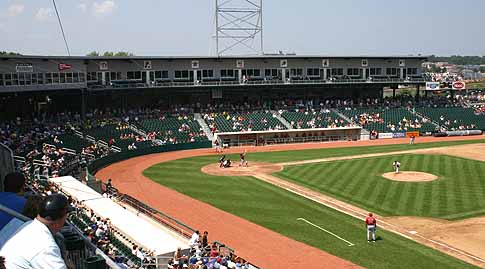 |
Regular visitors to BASEBALLPARKS.COM know that there were nine key ballparks — eight in the Minors — that I made a pledge to visit and review in 2005.
| Ballpark Stats |
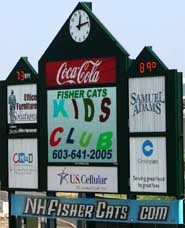 |
| First game: April 7, 2005 |
| Capacity: 6,500 (6,121 permanent seats, 379 in bleachers) |
| Architect: HNTB |
| Price: $22 million |
| Home dugout: 1B side |
| Field points: North by northeast |
| Playing surface: grass |
| Betcha didn’t know: In what must be a record, the first game here was played 11 months to the day after ground breaking |
Now that I’ve attended a very fun game in Manchester, New Hampshire, I’ve seen all nine. These nine represent all of the brand-new parks in the affiliated Minors, as well as the “new” big-league park, RFK Stadium in Washington.
With this article, I’ve now posted thorough reviews on all of the Big Nine. The travels to do these reviews have taken me as far south as Corpus Christi, as far west as Stockton, and now as far east — and north — as Manchester.
Four of the nine are sparkling new parks on the Double-A level, and that includes Fisher Cats Ballpark, home of the Eastern League’s New Hampshire Fisher Cats. You could almost include the new Greensboro park, since this Single-A facility was built to Double-A standards.
Do these five have anything in common? A better question might be what don’t they have in common?
All are ambitious projects costing over $20 million to build. They all feature an upper level with fancy luxury boxes and a press box, and a lower level with an open concourse at the rear of the seating bowl. You’ll find a gorgeous, color video screen in the outfield of each, as well as lots of food choices and well-thought-out areas for kids.
So how are they different from each other? Ahh, that’s where your intrepid ballpark reviewer has to roll up his sleeves and determine what makes each park unique, and assess whether those differences are positive or negative.
In Manchester, Fisher Cats Ballpark (I heard their broadcaster refer to it as “FCB,” so I will, too) is definitely a facility that the locals can be proud of, and it does offer some variations on the normal Double-A-park theme, particularly in its setting.
But how did the park, and the team for that matter, come to be here? A quick look at the team’s recent history shows that the franchise was known as the Ravens when they spent 1994 through 2003 playing in New Haven, Connecticut. There they played in wonderfully historic, but badly outdated, Yale Field (see the left-hand photo below), a facility that dates back to 1927. While it was a wonderful place to visit once or twice, not too many folks made a habit of attending, so the team committed to making a move to Manchester for the 2004 season. At first, the team announced that they would have the laughable name “the New Hampshire Primaries” in their new market. Cooler heads prevailed, and the name was altered to “Fisher Cats” before any permanent damage to the team’s reputation was done. As an aside, we found some merchandise with the “Primaries” name on it in the discount bin in the souvenir shop during our visit to Manchester this year. There didn’t seem to be many takers.
 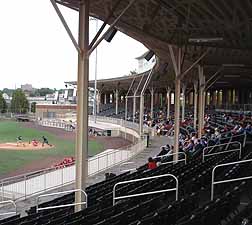 |
HNTB, architects of many of the outstanding Minor League parks built in recent years, was hired not only to design a brand-new park for downtown Manchester, but also to upgrade a temporary home. This one-year stop was at beautiful Gill Stadium (above right). Gill, which is also used for football, can claim that its site has been used for baseball since 1913. HNTB’s face lift for Gill cost about $4 million, and it made the already-lovely place an adequate facility for modern-day Double-A baseball, at least for a year. It must have inspired the players, because the team won the Eastern League championship in 2004.
Then came April 7, 2005, opening day in the new $22-million park. April 7 was 11 months to the day since the ground-breaking ceremony that launched the construction activity. It’s remarkable that a stadium that is this ambitious of a project was completed in that short a period. When you also consider that this was in a Northern climate where lots of construction days are lost to weather, this is even more unbelievable.
Normally, a new facility like this has a corporate sponsorship name, but since such a deal has yet to be struck, the fairly generic name “Fisher Cats Ballpark” is being used in the meantime.
Games here are a lot of fun, with jousting matches between innings, the tradition of jangling car keys and real New England clam chowder. Let’s take a close look at what it’s like to attend a Fisher Cats game, starting with the novel setting of the new park.
The Setting
The location of the Fisher Cats’ new ballpark is certainly novel. While not right in the heart of the business district, it is downtown, and its site allows views of the skyline of the city beyond left field. It’s also near a body of a water, as the Merrimack River flows gently along the west side of the park, and is clearly visible from the third-base concourse (see right-hand photo below). In my book, the two most desirable traits for a ballpark location are downtown setting and views of water. Fisher Cats Ballpark goes two-for-two. The only thing that could add to this would be active railroad tracks, giving it the perfect trifecta, like in Montgomery, Alabama and Davenport, Iowa. And guess what! FCB does indeed have trains rumbling by just beyond right field. Sounds like everything about the three-for-three setting is perfect, right?
Wrong. Because the park is essentially at the end of a dead-end street (South Commercial Street), you’d have to rank its accessibility as being suspect at best. Further, parking is a huge problem, as there is practically no parking within a block or two of the park. If you get there early enough, you can be one of the lucky few to park on the street or in the $10 (yikes!) lot a block from the park. Otherwise, you’ll be searching for a lot and hiking to see the game. And when the nearby arena has an event going on at the same time as a Fisher Cats game, the parking situation is even more problematic.
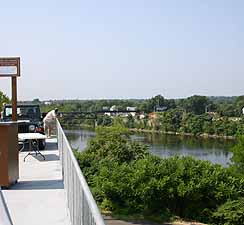 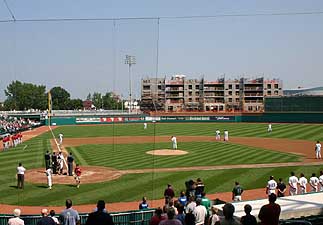 |
One other aspect of the setting is that there will soon be a hotel just a few feet beyond the left-field wall. The Hilton Garden Inn is currently under construction, and not only will it change the look of the ballpark when it is completed, it will also obscure the view of the skyline for many of the seats in the stands (above right). And this makes me wonder where the guests at the hotel will park. I hope it has a parking garage!
Another interesting aspect of the hotel is that games will be easily visible from dozens of its rooms. This should help in the development of the young players, since they’ll have to get used to being watched from hotel rooms if they make it to the “Bigs” with their parent club, the Blue Jays. Rogers Centre in Toronto, you see, is attached to a hotel where guests can watch games from their rooms. OK, this observation is done tongue-in-cheek, but it is interesting that hotels rooms are attached to both the Blue Jays’ Major League stadium and their Double-A park!
The Exterior
Another aspect of the park’s setting is that it renders the ballpark’s exterior relatively meaningless. That’s because most fans will park some number of blocks away, walk down the dead-end street, enter the stadium through the main gates near the left-field foul pole, and then exit the same way. In other words, they will see almost none of the exterior of this facility.
While most parks have elaborate facades and entryways behind home plate, FCB does not. The shot below shows what the average fan will never see: the exterior of the park behind home. Note there is no entrance for fans here at all.
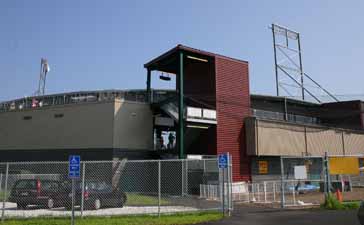 |
Both inside and out, the prevailing building material of the walls is corrugated steel. The color scheme is pleasing in its neutral tones. I’m sure the major reason for this look is to blend in with the old, commercial structures in the immediate vicinity.
Again, the only aspect of the exterior that most fans will see is the entry area beyond left field (even the backs of the left- and center-field walls are hidden by the hotel). This entryway is well-thought out, as there is a drop-off area where the street dead ends. There are multiple ticket windows and the larger of the two souvenir shops here. The latter is typically open whenever the ticket windows are.
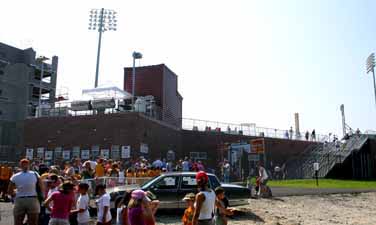 |
The (busy) shot above shows the hotel construction at the far left, the ticket windows in the left-center, the gates (behind which is the door to the souvenir shop) in the right-center, and the stairs that take you up to the concourse behind third base.
The Design
Just as you see HOK as the architects of park after park in the Majors, HNTB is the heavyweight name in the Minors. That’s the firm behind FCB’s design, and they certainly did some fine work. By no means is the open-concourse-under-the-luxury-suites look groundbreaking, but it was without a doubt what worked best for Manchester.
I was interviewed by the team’s fine play-by-play broadcaster, Bob Lipman, during the game I attended. It was inevitable that this subject would come up, and the way I addressed it was to point out that there is a reason why this two-level style is so pervasive at new Minor League ballparks: it works. One would have to observe that this approach is indeed the state of the art in 2005. It provides fans the wide-open concourse that they desire, and unlike the new Stockton park, it gives the luxury-suite holders their own level.
  |
Interestingly, there are no “berm” areas where families can sit on a blanket on a grassy hillside. Accordingly, the concourse is not “360 degrees.” In other words, you cannot walk from the left-field foul pole around to right field beyond the outfield wall like you can at most other new parks.
There is, however, a great deal of space beyond left field, although all of it is “paved.” There are countless picnic tables in this area, although they will often be reserved by groups (see right-hand photo above).
It is at this large left-field plaza where the main entryway is located. I’ve seen several fans write that they think it is odd that the main gate at the West Virginia Power’s new park is at the right-field foul pole, but at least in Charleston, there are several other gates for fans to enter. In Manchester, though, there is no need for ticket windows anywhere else, because other than a lightly used gate down the line from first base, there is no other way to get into the park. Undoubtedly this is due to the fact that 95% of the fans arrive at the site by walking down South Commercial Street, which brings you directly to the main entryway behind left field.
As with much of the exterior, there is a lot of neutral-colored corrugated steel on the walls of the interior. It is a pleasant, consistent look, and fits with the surroundings. In this regard, it is exactly the same approach used by HNTB in Charleston.
There’s one quirky design element that deserves to be mentioned. In fair territory in right field, the outfield wall juts out in an odd way (see below). There must be some practical reason why it does this — although I have no idea what it could be, because it wasn’t done this way for aesthetics.
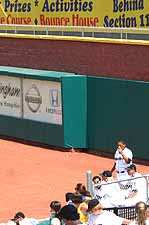 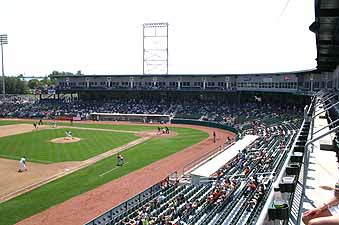 |
One element of the overall design that is troubling, especially at games like the one I attended, is the lack of air circulation in the main seating bowl. Because the concourses aren’t open on the front and back like at Pearl, Mississippi (or have wide gaps between the service areas like in Midland or Frisco, Texas), precious little wind cools the patrons in the seats. This is especially odd because there is a river, which usually means breezes, just a few feet away!
To be fair, my “home” park (the one where I live), the much-lauded Dell Diamond in Round Rock, Texas, has a big problem with this. Besides, I don’t think New Hampshire has an overabundance of 90-degree day games during an average season. I managed to pick one, though. The bottom line is that it was a little stifling in the seats.
The Essentials
The architectural design is nice enough, but where Fisher Cats Ballpark really shines is the so-called “game day experience.” To put it simply, it is a fun time, and I’m happy to add that it does so in an understated New England style — i.e., no screaming game hosts!
First, though, let’s look at the costs involved in attending a game in Manchester. Parking, and we’ve already established that there is a scarcity of it near the stadium, can cost as much as $10 if you want to park a block away. The lots farther away are cheaper, thank goodness.
If you want to sit in the first few rows of “premium” seats in the infield, it will cost you $12. That might be a tad high for Double-A, but the seats right behind them are $10 and the grandstand seats are only $6. If you want to sit in the one lonely section of bleachers in the right-field corner, it will cost you only $4.
There’s an alternative to this, by the way. For $23 apiece, you’ll get a meal and be able to sit at one of the picnic tables in left field. The Fisher Cats call this deal “Dinner in the Den.” For $27, you’ll get to eat and watch the game from the party decks at each end of the upper deck. These prices make the $22.50 for a meal and an upper-deck seat in Springfield, Missouri sound like a great bargain.
The prices of other essentials at this ballpark are reasonable, though. Game programs, which are jammed with information, are only $2. However there are two things I don’t like about the Fisher Cats’ program: it is printed on cheap “newsprint” paper and it’s not a standard size (for those of us who like to collect these things). The main souvenir shop near the entryway, as well as the souvenir stand behind home plate, are very well stocked and the prices are not out of line for a new Double-A park. For instance, most adult T-shirts are $17. It also makes me happy to report that they carry a couple different kinds of my favorite “souvenir” item, lapel pins.
Your family will be able to eat at the ballpark without breaking the bank. I always look at the price of a simple hot dog as a good barometer of how expensive food tends to be at a given ballpark, and FCB features dogs at a reasonable $2. Compare that to the $3.50 for a Fenway Frank at Boston’s stadium only 55 miles to the south.
All of the basic “ballpark food groups” are represented at FCB, but I’m thrilled to say that there is a special stand called “Chowdah House” that is devoted to seafood. Here you’ll find clam and lobster rolls, baskets with either shrimp or fish (either is $7.25, and that includes fries and cole slaw) and honest-to-goodness New England Clam Chowder ($3.50). Prior to the game, I eagerly targeted this last item to try before leaving the park that day. But here’s the thing (as Adrian Monk says on the USA Network series Monk): when I hungrily dashed to the Chowdah House stand at the beginning of the ninth inning, it had already closed. Even though the game took another 30 minutes to end, there was no chowdah for your famished reviewer to try.
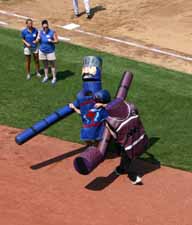 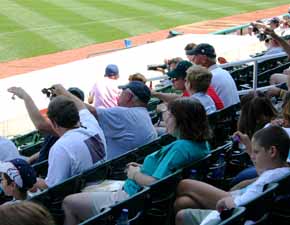 |
I enjoyed the traditions and non-standard entertainment at the Fisher Cats game. A tradition that the team has started is asking the fans to jangle their car keys until the home pitcher has delivered a strike in the top of the first (see right-hand photo above). Most of the fans dutifully complied, and it was a neat effect to start off a game. Similarly, the between-innings events were novel, fun and not-overdone. This means that the on-field “host,” a fellow who goes by the name Jackie B, avoids screaming into the microphone (I’m still trying to get over the manic host in Greensboro).
One between-innings event that caught my attention was jousting. Two contestants don heavily padded “suits of armor” that include fake heads that are velcroed to the top of the costumes, then they flail away at each other with soft jousting sticks until one knocks the “head” off of the other. In the photo above, the purple knight has just had his block knocked off by the victorious blue knight. It was both funny and entertaining.
Entertainment is the key at Fisher Cats games, and no constituency is pampered more at FCB than youngsters. Behind the stands is a large area of games and inflatables. Since the space isn’t utilized for pesky things like parking places or an entryway to the ballpark, it is perhaps the largest kids area I’ve ever seen at a sports facility. And because it’s right behind the stands, and in the flight path of foul balls, there is a massive net that covers the entire area. Good thinking!
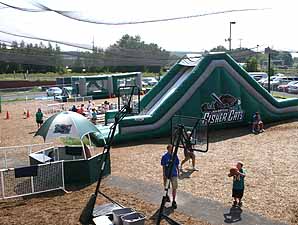  |
This play area is called Fungo’s Funland. Fungo, you see, is the name of the lovable mascot. In the picture above, he is armed with a water gun to cool off the overheated kids in attendance. One presumes that Fungo is a “fisher cat,” but regardless, the kids in attendance really seemed to adore him.
Last but not least, I need to mention the game-day staff of ushers, ticket-takers, concession-stand workers, etc. My wife, who has attended games at far more ballparks than almost fan you know, could not heap enough praise on the incredibly pleasant and helpful staff at this ballpark. You can have all of the neat concessions and joyous entertainment in the world, but if the workers don’t treat the patrons well, the fans will go home unhappy.
Summary
 |
On the Fisher Cats’ website, they ask the fans to “help us help you.” It says:
We with the Fisher Cats promote a family atmosphere and family environment. If at any time you feel uncomfortable or have a question, please do not hesitate to contact one of our staff members … We do not tolerate foul language or unruly conduct … We need your help in monitoring situations where fans use abusive language or have consumed too much alcohol. We enjoy working along with our fans to help make the ballpark a better, safer place to be.
All I can say to a mission statement like this is AMEN! There wasn’t a lot of drunkenness and screamed profanity at the midweek day game I attended (lots of day-care kids, but no drunks), so I can’t say that I witnessed this policy in action, but I trust that it is enforced when needed. I heartily commend the Fisher Cats for going to such efforts to make their games a family affair.
Certainly having affordable tickets, a great play area, a fun mascot and developing traditions like the key jangling add to the family-friendly atmosphere — even if the architecture isn’t novel and there isn’t enough nearby parking. But I do wish the chowder stand stayed open past the 8th inning!